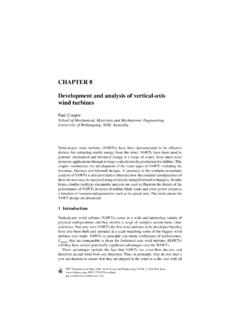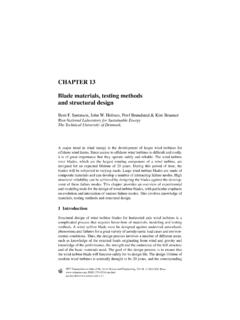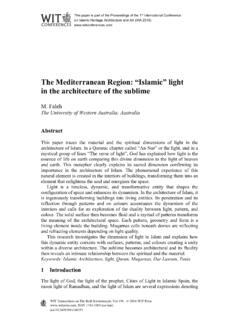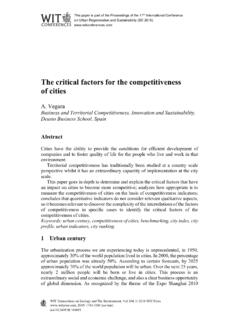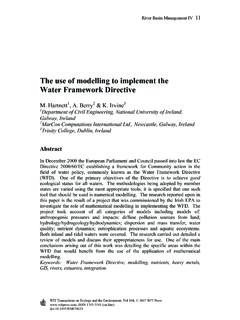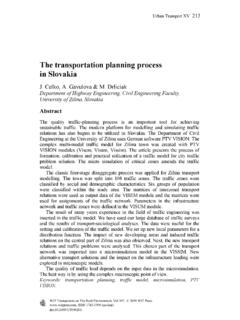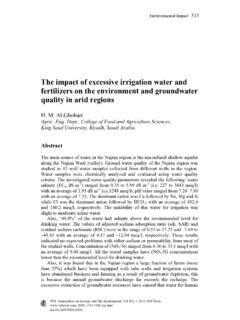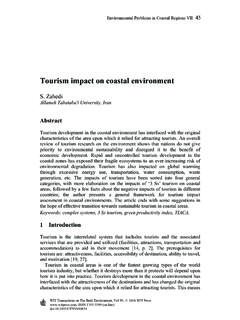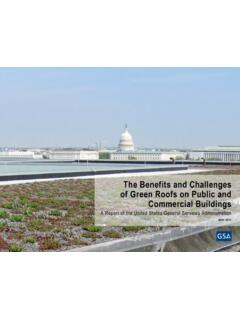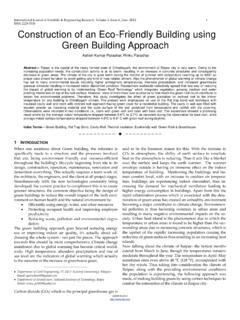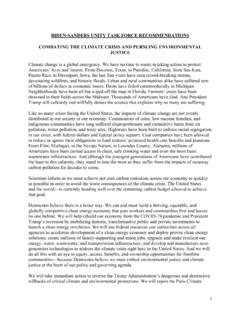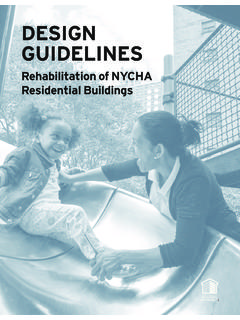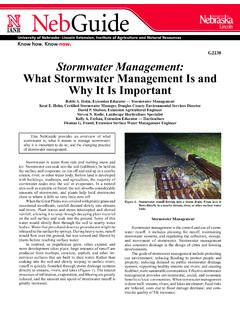Transcription of Architecture vs. nature: a reinvented relationship
1 Eco- Architecture V 37. Architecture vs. nature: a reinvented relationship P. Haupt Cracow University of Technology, Poland Abstract Architectural and urban design are influenced by more and more restrictive legislative regulations which go along with the increasing awareness of the impact of human activities on the environment. This trend is stimulating the development of sustainable technologies applied in Architecture . Incorporating elements of nature using their unique features supporting energy efficiency, air- quality control, water and sewage management systems can often be observed. Elements of nature may be implemented in the building itself, as well as in its surroundings and interior. Therefore there may be a new type of space observed in contemporary sustainable structures a transition space forming a soft edge between the building, its interiors and the city.
2 The paper describes the relationship between Architecture and nature; how it is being rediscovered by sustainable design and for Architecture to become the substance for the new city tissue. Keywords: sustainable design, green Architecture , Architecture vs. nature. 1 Introduction Owing to the social awareness of the consequences of the uncontrollable growth of cities, the need for sustainable development has become obvious. Subsequent legislation changes aiming at incorporating sustainable solutions into the design of buildings have caused the image of contemporary built environment to change. Architects and urban planners are encouraged to implement sustainable design through legislative and economical demands. We witness the introduction of low carbon, alternative energy, eco innovative advanced water management systems, land decontaminating and reusing processes, improving social structure investments developed across Europe.
3 Products of ecological agriculture are WIT Transactions on Ecology on The Built Environment, Vol 142, 2014 WIT Press , ISSN 1743-3509 (on-line). 38 Eco- Architecture V. offered, even fashion collections became environmentally conscious. This trend has stimulated the development of sustainable technology applied in the built environment public space, as well as buildings and their interiors. There is also the need emphasized not only to design rationally, but above all use buildings and spaces wisely, thus the humane aspect of sustainable development is constantly gaining more and more importance. The combination of these two trends is reflected in the composition of today's common space between the buildings, at the edge of the structure and its surrounding, as well as inside it, indicating the future direction in the ways of architectural and urban space arrangement.
4 2 Nature: back to utility The sustainability pursuit results in the need for a new approach to the relationship between Architecture and nature. The elements of the natural world, so far desired mainly due to their aesthetics, have now become useful elements, necessary for gaining energy, saving water, and improving air quality. However, they have not lost their aesthetic meaning. Natural elements have gained a new role of shaping development and public spaces and addressing new, unified perception of architectural and urban space. At the beginning of the twentieth century a quest in search for a new character of the relation between Architecture and nature began. In art and literature there was a rejection of a utilitarian role of nature observed.
5 Thus the aesthetic impression of natural elements became essential for Architecture , as an inspiration for ornament, form and background of the composition. Finally it took shape in the twentieth century, returning to its Vitruvian roots, being understood as a network of relations between man and nature instead of a whole in itself. Modernist Architecture tries to regain nature aesthetically as landscape changing a house into a dwelling machine' (Lisak [1]). Postmodern period is characterized by understanding the elements of nature as pawns in a game serving the aestheticization of an open or urban landscape. A. search for the essence of the relation between Architecture and nature in contemporary man's domain culture originated in the early nineteenth century.
6 Contemporarily nature becomes a material for Architecture and public spaces . man's place of residence. Natural elements, understood as the building material for a housing environment, are not just a landscape an aesthetical supplement to Architecture anymore. They are used practically as well. 3 Architecture and nature Thinking cityscape, the first association is a landscape built of structures: a conglomerate of buildings of different use, scale, form, creating more or less regular urban structure. Through sustainable design this usual image might be inverted. The buildings are often hidden concealed the green roofs, hidden into the ground for more efficient insulation creating a new topography in the existing natural landscape.
7 The example might be the London Grassroots community WIT Transactions on Ecology on The Built Environment, Vol 142, 2014 WIT Press , ISSN 1743-3509 (on-line). Eco- Architecture V 39. centre (Fig. 1). The design is innovative; the planted roof minimizes building's visual impact on the park's green space. The centre even offers a path network to allow visitors to circulate around and over the building. The structure reaches a maximum height of five metres, and the floor level is metres beneath ground level with grassed landscaping to the sides and roof . On the southern elevation Grassroots has several full height windows which contribute to passive solar heating and lighting. They also offer wide views over the southern section of park, thereby greatly contributing to the sense of security for park users.
8 Apart from sustainable technology the building was designed as a community centre for social contacts of the neighbourhood's society. Therefore it meets the ground rules for the green city worded by Brenda and Robert Vale: A green Architecture involves more than the individual building on its plot; it must encompass a sustainable form of urban environment. The city is far more than a collection of buildings; rather it can be seen as a series of interacting systems for living, working and playing crystallized into built forms (Vale and Vale [2]). The building is fully accessible to the mobility impaired, which emphasises its humane appearance. Figure 1: Grassroots Community Center, Eger Architects, London 2005, (photo: author P.)
9 Haupt, 2011). The new topography as an outcome of sustainable Architecture features might be created using natural landscape components, gaining the image that it was carved into the ground. On the other hand natural landscape may be used as an inspiration, imitating nature in an act of architectural creation that produces an artificial landscape, mimicking its diverse and complex form. This kind of concept derives from megastructural and cellular Architecture from the 1950s. Within its design principles there were: high variety of dwelling forms, flexibility of planning systems and originality and dynamism of architectural WIT Transactions on Ecology on The Built Environment, Vol 142, 2014 WIT Press , ISSN 1743-3509 (on-line).
10 40 Eco- Architecture V. expression (..) seen at the time as an appropriate answer to the sociological and formal dilemmas (Le nikowski [3]). Centre Jeanne-Hachette or Cite du Parc . the buildings by Nina Schuch representing this particular tendency, that have appeared in the 1970s in the Paris satellite town of Ivry-sur-Seine imitate natural terrain topography, and would probably nowadays be considered sustainable. Certain similarity might be found between the idea of designing non-repeatable individual units of flexible functionality connected into a biomorphic urban village and today's community system city. The large terrace gardens, green roofs are the features that served as prototypic to contemporary forms such as the multifamily residential and office building by Delugan and Meissl in Vienna (Fig.)
